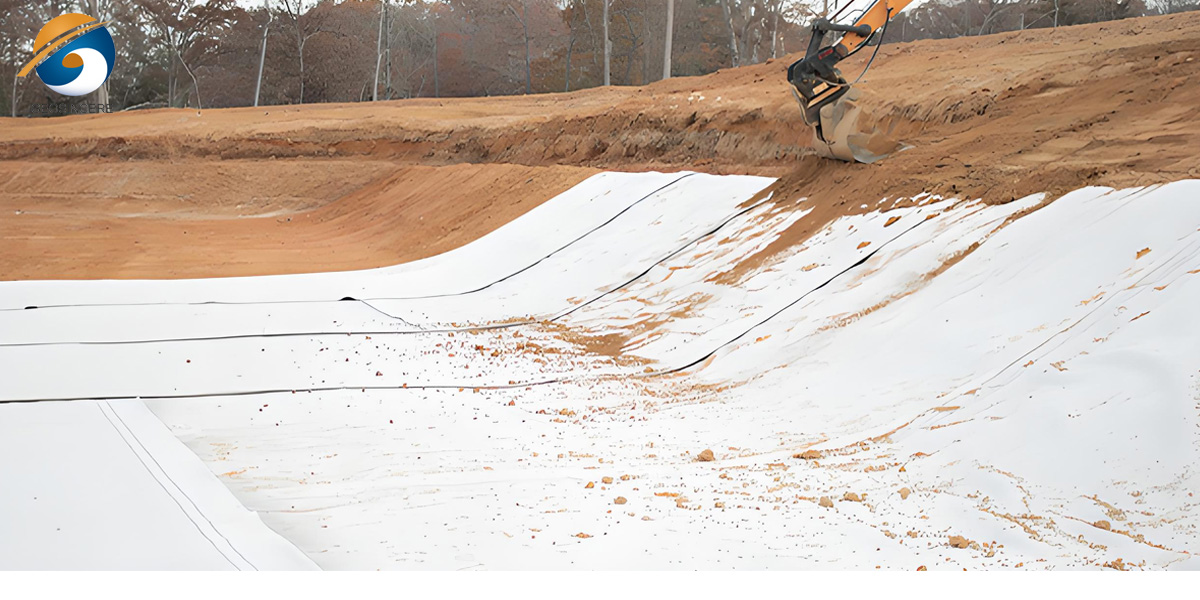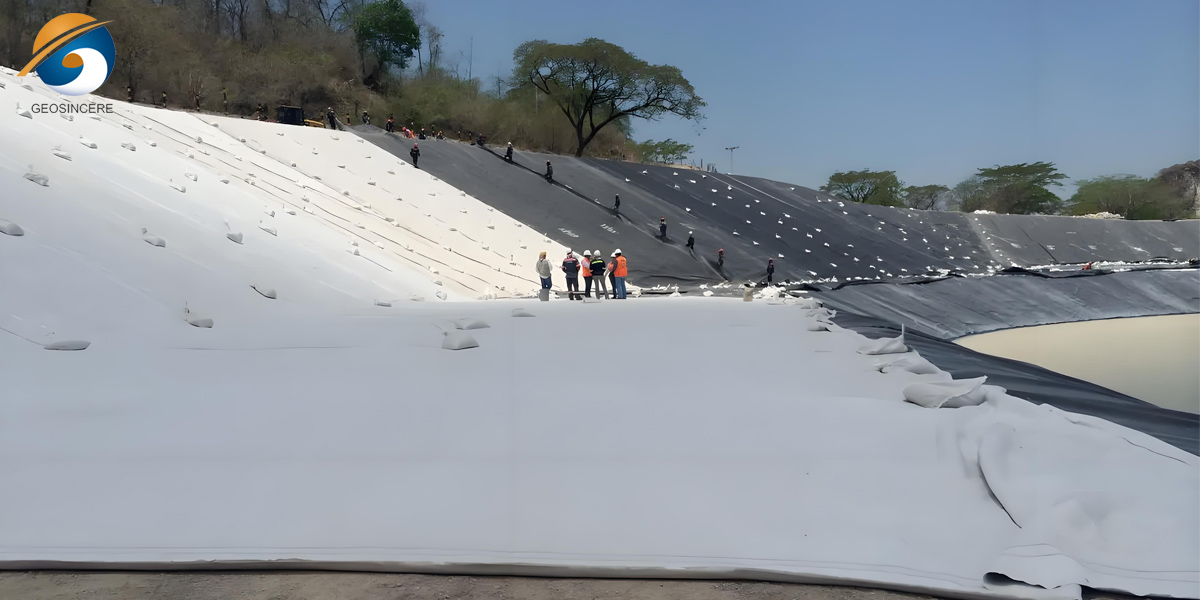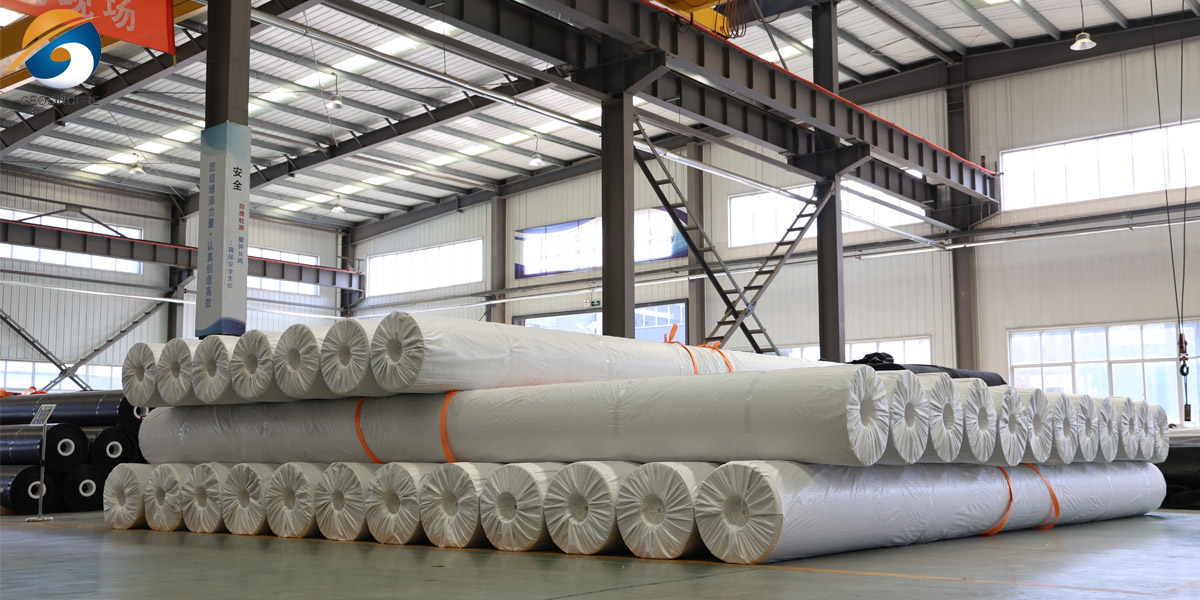Ultimate Guide To Choose Geosynthetic Clay Liner
Geosynthetic clay liner is a composite cloth consisting of a layer of sodium bentonite clay sandwiched between two layers of geotextile fabric. The bentonite clay swells when it comes into contact with liquid, forming a barrier with low permeability. Geosino Geosynthetic clay liner is perfect for purposes the place excessive energy and puncture resistance is required, such as landfills, lagoons and ponds. The geotextile layers furnish brought energy and steadiness to the material, which is vital in areas the place heavy hundreds are expected.
The price of a geosynthetic clay liner tiers from $1.50 to $5.00 per rectangular foot, whilst the average price of a geosynthetic clay liner machine (including installation) levels from $4 to $7 per rectangular foot. However, the price of a geosynthetic clay liner can also no longer firstly be the most inexpensive alternative at the outset, however it can supply long-term price financial savings due to its sturdiness and effectiveness in decreasing seepage.
1. What Key Factors Should Be Considered When Choosing a Geosynthetic Clay Liner (GCL)?
Selecting the proper Geosynthetic Clay Liner (GCL) is essential to making sure long-term performance, environmental protection, and compatibility with site-specific conditions. Below are the critical elements that engineers, contractors, and designers ought to consider earlier than deciding on a GCL product for containment functions such as landfills, ponds, reservoirs, or mining sites.
1.1 How Important Is the Hydraulic Performance of a Geosynthetic Clay Liner (GCL)?
Hydraulic overall performance is one of the most imperative concerns when deciding on a GCL. The cloth should act as an high quality barrier to water and contaminants.
- Low permeability: A GCL must showcase a saturated hydraulic conductivity of ok ≤ 5×10⁻¹¹ m/s to make sure high-quality long-term containment of drinks and leachates.
- Bentonite quality: High-quality sodium bentonite with a swell index of ≥ 24 mL/2g is essential. It permits the GCL to swell and structure a low-permeability seal when hydrated.
- Advective and diffusive float resistance: In addition to stopping liquid flow, the GCL liner have to face up to diffusion of contaminants via the barrier, in particular in chemically aggressive environments like landfills and mining leachate ponds.
1.2 What Physical and Mechanical Properties Are Critical for a Geosynthetic Clay Liner ?
GCL liner ought to face up to the bodily stresses of transportation, handling, and set up whilst preserving structural integrity as soon as deployed.
- Peel power (≥ sixty five N/m): Strong bonding between the layers (nonwoven fabric, bentonite, and woven fabric) ensures the GCL stays intact for the duration of unrolling and seaming.
- Grab tensile electricity (≥ 800 N): High tensile power is fundamental to face up to tearing in the course of placement and to assist slope balance in steep or difficult terrains.
- Puncture resistance (≥ five hundred N): Essential for defending the liner from injury brought about through sharp stones, irregular subgrades, or building tools pressure.
1.3 How Does Chemical Compatibility Impact a Geosynthetic Clay Liner?
In purposes the place the GCL might also be uncovered to aggressive chemicals, evaluating its resistance to these marketers is crucial.
- Chemical resistance: The bentonite’s capability to withstand degradation when uncovered to leachates, salts, acids, and hydrocarbons is a key overall performance indicator. Testing per ASTM D6766 helps verify chemical compatibility.
- Calcium vs. sodium bentonite: While sodium bentonite gives top-quality swelling and sealing capacity, it can lose effectiveness in high-salinity environments. In such cases, chemically modified bentonite or GCLs handled for salt resistance may additionally be required.
1.4 What Role Do Thickness and Bentonite Weight Play in a Geosynthetic Clay Liner ?
The quantity and fantastic of bentonite used inside the GCL affect its hydraulic and mechanical performance.
- Thickness: GCLs usually enlarge to 5–7 mm after full hydration. Thicker liners might also provide higher sealing and stress distribution.
- Bentonite mass per area: A greater bentonite content—≥ 3.5 kg/m²—provides multiplied impermeability, higher resistance to desiccation, and multiplied sturdiness below stress or load.
1.5 What Types of Reinforcement Are Available for Geosynthetic Clay Liner, and How Do They Differ?
The reinforcement technique used to bond the GCL layers drastically impacts the liner’s strength, shear resistance, and utility suitability.
- Needle-punched GCL: These are the most many times used. The layers are routinely bonded by means of heaps of small fibers punched via the material, presenting high-quality interior shear electricity and durability, in particular on slopes.
- Stitch-bonded GCL: These use stitching to keep the layers together. They are greater reasonable however provide decrease inside power and may additionally be much less appropriate for high-stress applications.
- Adhesive-bonded (glued) GCL: These are bonded the usage of adhesives and are appropriate solely for flat, low-load environments the place shear forces are minimal.
1.6 What Environmental and Installation Conditions Should Be Considered When Using a Geosynthetic Clay Liner ?
Site stipulations and publicity play a sizable position in the choice and sturdiness of a GCL.
- UV resistance: If the GCL will be quickly uncovered earlier than cowl substances are placed, it have to provide UV balance for up to 30–60 days. Extended publicity can degrade the geomembrane or geotextile layers.
- Hydration timing: Improper prehydration (wetting earlier than full set up and cowl placement) can minimize the liner’s sealing performance, particularly if the web page has salts or high-pH water.
- Subgrade preparation: A smooth, well-compacted subgrade is critical to forestall punctures and make sure full contact between the bentonite and the base soil, which is indispensable for uniform swelling and sealing.
2. Factors Affecting the Price of Geosynthetic Clay Liner
2.1 Geosynthetic Clay Liner Raw Materials
The fee of uncooked substances used in geosynthetic clay liners manufacturing, together with bentonite, geotextiles, and polymer additives, substantially influences the universal charge of geosynthetic clay liner. Fluctuations in the costs of these substances can have an effect on geosynthetic clay liners pricing.
2.2 Geosynthetic Clay Liner Manufacturing Process
The complexity of the manufacturing process, first-rate manipulate measures and technological developments have an effect on manufacturing fees and consequently geosynthetic clay liners prices.
2.3 Geosynthetic Clay Liner Thickness and Gauges
Geosynthetic clay liner is accessible in a number thicknesses and gauges and can be tailor-made to unique challenge requirements. Thicker pads with greater overall performance specs may additionally command a greater rate due to elevated cloth and manufacturing costs.
2.4 Geosynthetic Clay Liner Market Demand and Supply
Supply and demand dynamics in the geosynthetics market, influenced by way of infrastructure development, environmental guidelines and development activities, can also affect geosynthetic clay liner prices.
2.5 Geosynthetic Clay Liner Transportation and Logistics
Transportation prices (including transportation and handling) play a position in deciding the ultimate rate of a geosynthetic clay liner, particularly for initiatives placed in far off or inaccessible areas.
3. Latest Trends in Geosynthetic Clay Liner Pricing
According to enterprise reviews and market analysis, geosynthetic clay liners pricing has skilled the following developments in current years:
3.1 Steady Growth: Overall, costs of geosynthetic clay liners have been rising gradually due to rising demand, inflationary pressures, and rising uncooked cloth and manufacturing costs.
3.2 Technological Advances: Investments in R&D have led to the introduction of superior geosynthetic clay liners formulations with stronger overall performance characteristics. While these improvements provide increased functionality, they can come at a greater price.
3.3 Market Competition: Increased opposition amongst geosynthetic clay liners producers has resulted in pricing pressure, with some suppliers imparting aggressive pricing techniques to acquire market share.
These charge levels may also range primarily based on precise task requirements, location, suppliers and market conditions.
Geosynthetic clay liner play a imperative position in environmental containment applications, however their pricing can fluctuate broadly based totally on a range of factors, inclusive of uncooked materials, manufacturing processes, specifications, market dynamics and transportation costs. Understanding these elements and current pricing developments is quintessential to venture planning, budgeting, and buying decisions. By conducting a thorough price evaluation and evaluating a number vendors, challenge stakeholders can make knowledgeable selections that optimize task effects and costs.
4. Outstanding Advantages of Geosynthetic Clay Liner (GCL)
Geosynthetic Clay Liner (GCL) provide a vary of great advantages that make them an best preference for contemporary waterproofing and containment applications. Their herbal composition, self-healing properties, and adaptability to a vast vary of environmental stipulations make GCLs a dependable and eco-friendly answer for quite a number civil engineering and environmental safety projects.
4.1 Geosynthetic Clay Liner Permanent Waterproofing
GCLs are composed specially of outstanding herbal sodium bentonite, which varieties a gel-like seal when hydrated. Unlike artificial liners, bentonite does no longer age or degrade over time, presenting a long-lasting water-proof barrier. GCLs are environmentally friendly, protected for aquatic ecosystems, and have no damaging impact on the best of saved water or the increase of aquatic flora and animals.
4.2 Geosynthetic Clay Liner Extremely Low Permeability
The permeability coefficient of a ordinary GCL is as low as 1.0 × 10⁻⁹ cm/s, supplying most appropriate impermeability. It can face up to hydrostatic pressures of over 1.0 MPa, making it noticeably fine in purposes requiring impervious containment of drinks and leachates, such as landfills, ponds, or reservoirs.
4.3 Geosynthetic Clay Liner Excellent Cold-Weather Performance
GCLs can be hooked up and operate reliably in severe temperature conditions. They continue to be useful even in sub-zero temperatures as low as -32°C, which makes them appropriate for use in bloodless areas or seasonal climates barring compromising sealing performance.
4.4 Geosynthetic Clay Liner Simple and Efficient Construction
Installation of GCLs is simple and does now not require complicated procedures. Once the liner is laid over the organized subgrade, it can be at once **covered with backfill soil besides the want for intensive sealing or joint treatments, notably decreasing set up time and labor costs.
4.5 Geosynthetic Clay Liner Flexible and Settlement-Resistant
Thanks to their composite shape and the herbal houses of bentonite, GCLs can accommodate floor movements, making them best for areas with uneven settlement, minor subsidence, or frost heave. This helps preserve liner integrity in dynamic soil environments.
4.6 No Special Installation Equipment Required
Unlike geomembranes that might also require specialised welding or anchoring equipment, GCLs can be mounted the use of standard earth-moving tools. This reduces the want for quite expert labor and minimizes gear apartment or coaching costs.
4.7 Self-Healing and Easy to Repair
One of the most huge advantages of GCLs is their self-sealing capability. If by accident punctured through small sharp objects (e.g., roots or stones), the bentonite swells and fills in the voids, restoring the liner's impermeability. In the match of bodily damage, easy localized repairs are generally sufficient, supporting to limit ongoing maintenance costs and prolong the overall undertaking lifecycle.
5. What Are the Typical Applications of Geosynthetic Clay Liner ?
Geosynthetic Clay Liner (GCL) is extensively used in a range of civil and environmental engineering tasks due to their magnificent waterproofing and containment properties. Geosino’s GCL merchandise are in particular perfect for initiatives that require dependable anti-seepage performance, long-term durability, and ease of installation.
GCLs are in many instances utilized in synthetic lakes, reservoirs, large-scale swimming pools, fish and shrimp farms, canals, and strong waste landfill sites, the place they characteristic as a enormously high quality barrier to forestall water leakage and defend surrounding soil and groundwater from contamination.
They are additionally well-suited for structures and underground constructions uncovered to excessive water stress or severe temperature fluctuations—such as basements, tunnels, subways, and underground storage facilities. In these applications, GCLs serve as a reliable water-proof layer that adapts to motion and environmental stress.
In addition, GCLs are best for the sealing, isolation, and lining of water diversion channels, stormwater ponds, industrial containment systems, and sludge drying beds, supplying dependable chemical resistance and long-lasting impermeability.
6. Conclusion
Geosincere Geosynthetic clay liner is a new kind of geosynthetics. It is made by means of filling sodium-based bentonite particles between woven geotextiles and non-woven geotextiles, and connecting the non-woven cloth fibers of the top layer to the woven cloth of the decrease layer thru bentonite particles, one of a kind techniques and equipment, and extraordinary methods. The bentonite particles in the water resistant blanket made by way of this approach do no longer go with the flow in one direction, so a uniform water-proof layer can be fashioned in the complete range. It is an high-quality water resistant and anti-seepage cloth and can be extensively used in water resistant and anti-seepage initiatives underneath many development conditions.
7. Choosing a Good Geosynthetic clay liner Supplier
Shandong Geosino New Material Co.,Ltd (Brand:Geosincere) is the expert Geosynthetic clay liners and geosynthetics producer and wholesaler positioned in Shandong Province, China. We are an expert manufacturer, exporter and wholesaler for such geosynthetic merchandise as HDPE Pool Liner, geotextiles, geogrids, geocells, geosynthetic clay liners (geosynthetic clay liners), drainage boards, etc.
We have been exporting Geosynthetic clay liners and geosynthetics to over 60 nations such as Australia, France, Sweden, UK, Hong Kong, Hungary, New Zealand, Poland, Mexico, Ecuador, Brazil, Pakistan, Bangladesh, Thailand, Vietnam, Malaysia, Indonesia, Singapore, Philippines, Sri Lanka, India, UAE, Saudi Arabia, Qatar, Kenya, Ghana, Ethiopia, Somalia, Nigeria, South Africa, Switzerland, Mongolia, etc. They pick Geosincere as companion for greater than 10 years.
GEOSINCERE Geosynthetics has been maintaining on investing in technological innovation, manufacturing services enchancment and turnkey engineering abilities. We have invested 10 million greenbacks into our manufacturing manufacturing unit which is outfitted with brand new computerized manufacturing strains to manufacture excessive first-rate Geosynthetic clay liners and different geosynthetics with optimized processes. Our significant traces of geosynthetics products are nicely recognised for their ensured quality, excessive performance, great sturdiness and nice price effectiveness.








